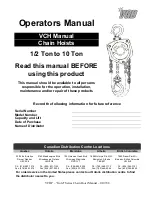
Page 3
SECTION I - INTRODUCTION
1-5. Application Information
This hoist is intended for general industrial use in the lifting
and transporting of freely suspended material loads within its
rated load. Prior to installation and operation, the user should
review his application for abnormal environmental or handling
conditions and to observe the applicable recommendations as
follows:
a. Adverse Environmental Conditions. Do not use the hoist
in areas containing flammable vapors, liquids, gases or any
combustible dusts or fibers. Refer to Article 500 of The
National Electric Code. Do not use this hoist in highly
corrosive, abrasive or wet environments. Do not use this
hoist in applications involving extended exposure to ambient
temperatures below - 10°F or above 130°F.
b. Lifting of Hazardous Loads. This hoist is not recommended
for use in lifting or transporting hazardous loads or materials
which could cause widespread damage if dropped. The
lifting of loads which could explode or create chemical or
radioactive contamination if dropped requires fail-safe
redundant supporting devices which are not incorporated
into this hoist.
c. Lifting of Guided Loads. This hoist is not recommended
for use in the lifting of guided loads, including dumbwaiters
and non-riding elevators. Such applications require additional
protective devices which are not incorporated into this hoist.
Refer to your state and local regulations governing the
requirements for elevator and dumbwaiter installations.
1-6. Warranty
Every hoist is thoroughly inspected and tested prior to shipment
from the factory. Should any problems develop, return the
complete hoist prepaid to your nearest Yale Authorized Warranty
Repair Station. If inspection reveals that the problem is caused
by defective workmanship or material, repairs will be made
without charge and the hoist will be returned, transportation
prepaid.
This warranty does not apply where: (1) deterioration is caused
by normal wear, abuse, improper or inadequate power supply,
eccentric or side loading, overloading, chemical or abrasive
actions, improper maintenance or excessive heat; (2) problems
resulted from repairs, modifications or alterations made by
persons other than factory or Yale Authorized Warranty Repair
Station personnel; (3) the hoist has been abused or damaged
as a result of an accident; (4) repair parts or accessories other
than those supplied by Yale are used on the hoist. Equipment
and accessories not of the seller's manufacture are warranted
Rated
Lift Speed
Model
Load
At Rated Load
Motor
Number
(Lbs)
(Ft. Per Min.)
HP
LEW 1/2-(+) ** 10*2
1000
10
½
LEW 1/2-(+) ** 16*2
1000
16
½
LEW 1/2-(+) **21*2
1000
21
¾
LEW 1/2-(+) ** 32*2
1000
32
1
LEW 1-(+) ** 10*2
2000
10
¾
LEW 1-(+) ** 16*2
2000
16
1
+ Specify lift required - see catalog and/or price list.
* Specify reeving - S (Single), D (Double-Cross Mounted or P (Double-
Parallel Mounted).
** Specify suspension - LG, PT, GT, MT/RT.
Table 1-1. Basic Hoist Data
only to the extent that they are warranted by the manufacturer.
EXCEPT AS STATED HEREIN, YALE MAKES NO OTHER
WARRANTIES, EXPRESS OR IMPLIED, INCLUDING
WARRANTIES OF MERCHANTABILITY AND FITNESS FOR
A PARTICULAR PURPOSE.
2-1. Safety Notes
a. Inspect the hoist for any evidence of shipping damage or
loose parts.
b. The supporting structure and load attaching devices should
have a load rating at least equal to that of the hoist.
c. This hoist is not suitable for use in uncovered outdoor
locations or areas containing explosive dust, vapors or gases.
d. The installation area must provide safe operating conditions
for the operator, including sufficient room for the operator
and other personnel to stand clear of the load at all times.
2-2. Trolley Installation
Yale trolleys can be mounted on American Standard I Beams
from 6 to 18 inches high. Adjustment for different beam
dimensions is accomplished with the proper placement of
spaced washers as described below.
a. "I"-Beam Adjustment. Adjustment for "I" beam sizes and
tolerances is accomplished by locating the spacer washers
as shown in Figures 2-I, 2-2, and 2-3. Tables 2-I, 2-2, and
2-3 provide an approximate guide to washer placement. Be
sure to use the proper Table, based on lift and trolley-type
of the particular installation.
BEAM MANUFACTURING TOLERANCES ALLOW WIDE
VARIATIONS FROM HANDBOOK FLANGE WIDTHS, AND
SLIGHT CHANGES TO RECOMMENDED WASHER
DISTRIBUTION MAY BE NECESSARY TO SUIT SPECIFIC
INSTALLATIONS.
The particular beam on which your hoist is to be installed
should be measured and trolley spacer washers adjusted
as required to achieve a clearance of ;/.,2" to 1/8".
Trolleys can be mounted on beam radii as small as 4 feet.
Slightly increased spacing may be required when the trolley
is mounted on curved beams to maintain freedom of
movement.
The load pin nuts for the trolleys require a tightening torque
of 100 ft. lbs. Refer to Figures 2-1, 2-2, and 2-3 for nut
identification.
b. Periodic Inspection. The trolley should be inspected
periodically for evidence of excess wear or overload. Parts
should be replaced as required.
c. Lubrication. Trolley wheels are equipped with sealed, lifetime
lubricated, precision ball bearings which should not require
lubrication for the normal service of the trolley.
2-3. Power Supply Connection
a. Disconnect power before making connections.
b. Voltage supplied to the hoist should be within plus or minus
10% of the voltage specified for the hoist. Hoists are tagged
at the factory with a tag indicating the voltage for which the
hoist is wired. Standard single-phase hoists are convertible
from 115 to 230 volts. Standard single-speed, 3 phase hoists
are convertible from 460 volts to 230 volts. See the wiring
section (paragraph 7-1) for voltage conversion instructions.
For more information contact: Sievert Crane and Hoist, (708) 771-1600, [email protected], www.sievertcrane.com



















